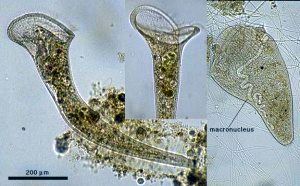
Resembling a trumpet or vase, varieties of stentor make up the largest known single-celled aquatic creature. Their name comes from the epic poem, “The Iliad,” in which Homer characterizes a herald, Stentor, as having a voice “as powerful as fifty voices of other men.”
As with vorticella, the eating orifice of the trumpet animalcule is circled about with tiny hair like cilia. These hairs wave in sequence, sweeping food into its oral cavity. See the beautiful video (below), filmed by Dr. Ralf Wagner. It highlights the feeding process.
In the vast majority of instances, organisms are made up of one or more cells, each with its own nucleus. The nucleus governs cell function and participates in cellular division or reproduction, providing a complete DNA copy to each resultant cell. This is not the case for our trumpet shaped friend.
Two Different Kinds of Stentor Nuclei
There is an unusual sort of nucleus in the creature’s single cell. It is called a macronucleus, the prefix macro meaning large. That nucleus resembles a string of beads, as this photo by Udo M. Savalli illustrates. This form of nucleus controls day-to-day function, including protein manufacture. It does not participate in reproduction.
Fine Structure
Care to visualize our microscopic friend close-up? The fine structure of S. polymorphus, not easily seen, has been studied under light microscope. For instance, about 250 adoral membranelles¹ aligned in series ring it’s mouth. This is called a peristomal cap. The cilia there are organized in three rows, each containing approximately 20 to 25 individual hairs. Other structures exist throughout the body. A scholarly 45-page detailed article in PDF format may be downloaded free. In addition, a copyright free, e-book called The Biology of Stentor is available.
Reproduction
At the time of reproduction, the macronucleus disappears, and reproduction is accomplished with a smaller, micronucleus. The micronucleus copies itself, and a copy from each participant is exchanged between the two organisms. Afterward, the micronuclei in each microorganism reorganize to form two new macronuclei. Then the organisms asexually produce new animals.
1 Individual structures around the mouth of ciliates.
Note: You might also enjoy Volvox Reproduction and Morphogenesis
References:
- MadSci Network How does a Stentor Reproduce?
- Johnson County Community College: Phylum Ciliophora – Stentor
- NCBI: Fine Structure and Function in Stentor polymorphus
- Archive.Org: The Biology of Stentor (free electronic book)
← Back to Classic Science
← Home
